 |
|
The
solo traverse of the Arctic Ocean by the North Pole with a Kite
Congratulations Mike |
| Français | Wokipi | |||||
|
Mike
arrived back at the North Cape, Norway to meet his wife Cathy and
2 children (starting and finishing point of his expedition), 27
months later, exhausted, but in very good shape. Mike reached this
almost impossible goal. He says, "Man,
am I happy to be here! After all this time, it's great to be back.
I sometimes thought I would never make it - but I did - and I'm
proud of myself!"
He traversed, only, more than 20 000 km, the North Cape to Greenland,
Nunavut to Alaska, then through all Siberia and return to the the
North Cape … He faced the cold, the ice, the wind, the polar
bears, extreme loneliness and the fear always present, but He succeeded
Thursday, October 21st, he completed his turn of the world by the Arctic Circle. It had left on August 4, 2002. His modes of transport were sailboat, kayak, bike, skis, and when possible, a kite. Mike covered 20'000 km, traversing over Greenland, Canada, Alaska, the Russian Federation and Norway, and sailing over the Greenland Sea, Davis Strait, Bering Strait and the White Sea, using only his general knowledge, good equipment, physical strength and determination as his resources. Mike Horn's adventure of the century, otherwise known as 'Arktos', was composed of 10 stages: 4 on the sea and 6 on land. Arktos :The word Arctic comes from the ancient Greek word <Arktos> meaning <bear>. The Arctic region is, in fact, the zone where the polar bear lives, whereas in the Antarctic, the polar bear does not exist. |
|
|
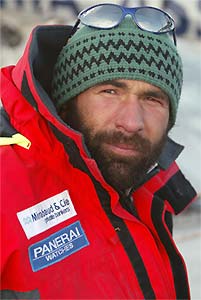 |
Account
of its adventure : North Cape , Departure day , Sunday the 4th of August,2002 It was 15:15hrs when Mike sailed past the sheer rock cliffs of the North Cape, the northernmost tip of Norway. It was a clear day. The rain had stopped and there was an amazing luminosity in the air. The boat stood out clearly on the dark waters of the Arctic Ocean and Mike, dressed in red, could easily be seen by his family and friends that were following him on a local fishing boat. Mike can now sail through to Greenland and afterwards to Canada with less risk of running into icebergs. His 14 m. aluminium boat is perfectly designed for Arctic conditions. Once reaching Greenland, Mike will hand the boat over to the logistics team who will then sail it around the southern point of Greenland. During this time Mike will continue on foot and cross over the ice cap of Greenland on foot and ski. Mike will meet up once again with his boat on the west coast of Greenland and then sail through to Canada as far west as possible without the risk of being caught in the ice. The boat will then return to Europe and Mike will continue through Canada, Alaska, the Bering Strait, and Siberia on foot, ski or kayak, obviously modifying his transport modes in relation to climatic conditions and terrain. |
|||
| Stage
1 completed - Mike arrives at Greenland - 17th August 2002 - At 1600hrs, Mike arrived at the port of Angmagssalik on the eastern coast of Greenland. Angmagssalik, a small Inuit village of 1200 inhabitants is where logistics crew were able to meet him. "The last few days were stressful. Huge icebergs started appearing and then the fog came in. I couldn't see 5 meters in front of me. I didn't sleep for 4 days - it would have been too risky !" The traverse of the Greenland Sea from the North Cape until the east coast of Greenland took 13 days with northwesterly winds and an average speed of 6-9 knots. Mike will be leaving again in a few days. Once on the ice cap Mike hopes the traverse will be relatively smooth. Due to cold temperatures the ice conditions are apparently good and if weather permits he will be able to use a kite to help pull him along. |
||
2nd
stage - Mike Horn completes the traverse of Greenland - 13th september
2002 - After this bad start conditions slowly started to improve. The winds turned and I was able to use the kite to pull me on my skis. What a pleasure to get speed at long last! With the kite I could easily cover 60kms in a day. My record day was 143 kms. The more ground I covered in the day, the more food I could eat as well, so that was a great bonus." |
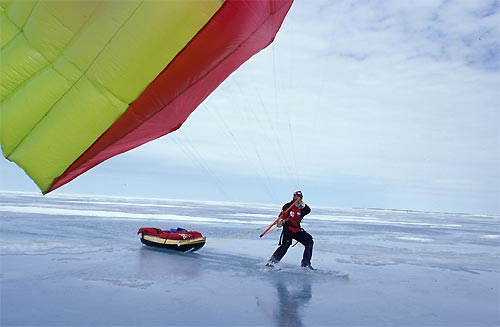 |
|||
| The
kite : efficient but dangerous. Mike's kite is adapted to the
special conditions of this expedition. In general, the kite can pull
a man at more than 100km/hr. With the extreme conditions of the Great
North, Mike must be extremely careful when he uses the kite. The terrain
is irregular, visibility difficult and the greater the speed the greater
the risk of freezing the hands or face.Mike will use the kite to pull
himself up and over the huge blocks of ice and reduce the weight of
the sledge. |
|
|
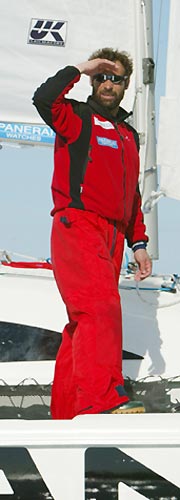 |
3rd
Stage - After a few days of rest - stage 3 will commence - sailing westwards - destination Canada. On the 30th of September, Mike moored his boat at Nanisivik, a small mining village off the northern coast of Baffin Island. He has reached the point of no return - behind him the ice was closing up. 4th stage - Mike Horn leaves on foot - 6 November 2002 - From Nanisivik, he could now head off on foot. With 5'000 kms of the 20'000 behind him, Mike is now ready for stage 4 of the expedition. This involves the traverse on foot and ski of the North-Western Territories of Canada, heading westwards towards the Bering Strait in Alaska. "When I arrived in Nanisivik, there was too much ice to use the kayak, but yet, it was not solid enough to start off on foot, so I had no choice but to wait for a few weeks. This is nature and I must go with it, not against it." The water is now frozen and is thick enough to bear Mike's weight, and the weight of his sledge, heavily laden with equipment and supplies. The locals have warned him about the polar bears, which use the firmer ice for their southward migration in search of food, so Mike must remain permanently on the alert. "Dealing with polar bears will be a bit like dodging ice bergs and growlers. I'll also have to set up my 'bear watch' system and must be extra careful with storing my food, and when cooking." 11th of November 2002 - Mike Horn returns to Arctic Bay! It's rather frustrating to have to retrace your footsteps, but given the conditions of the ice Mike had no choice! The strong winds had created pressure ridges on the ice. "There I was with 300 meters of open water in front of me! Temperatures are once again back up to -15°C (what the locals call a late summer!) We just need a few days of really cold weather and no winds and I'll be able to leave again." 26th of November 2002 - Mike Horn leaves Arctic Bay - Stage 4 begins ! For almost two months, Mike has been blocked in Arctic Bay due to the unusually warm temperatures for this period. Finally, the temperatures over the last two weeks have dropped to a constant -30°C and the ice is slowly thickening. At midday today Mike left Arctic Bay - starting his trek across the Northwest Territories of Canada. |
|||
| 10th
of January 2003 - Tent and belongings up in smoke!! Only ashes remain at Mike's campsite position. "I wasn't able to do a thing. I was changing the fuel bottle on my stove and on opening the screw top, the fuel sprayed out under high pressure all over the tent. The tiny flame still remaining on the stove was enough to set the whole tent alight in a flash. It ravished everything inside the tent within seconds. It was so quick the only reaction I had was to save myself! My sledge and its contents are all that I have at present. My sleeping bag went up in smoke, my down jacket, maps, argos, everything that was in my tent! Luckily, my telephone and GPS were safe so I was able to ring my friend in Arctic Bay who has arranged for help to be sent from Igloolik. I have built an shelter in amongst the pack ice for the evening. It will be a long wait with only a windstopper and a few candles to keep me warm. Once back in Igloolik, I will be able to establish the damage and will need to replace everything that I have lost. My logistics team will bring me new equipment next week and I will get moving again as soon as possible." Twelve hours later, Mike's help team finally arrives and he is now heading back to Igloolik to assess the damage to his equipment. He was obliged to head back to civilisation to collect the new supplies bought over from Europe by his logistics team. |
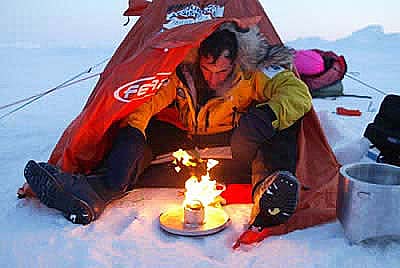 |
|||
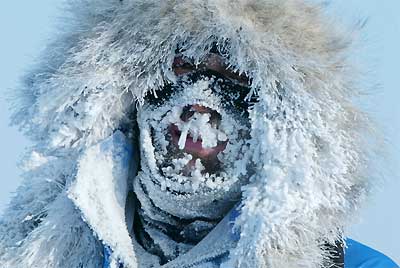 |
28th
February 2003 - Mike Horn arrives in Pelly Bay ! I've never experienced such cold temperatures before. Getting through each day was like climbing over yet another hurdle…. and what joy it is when you finally get into your tent every evening and shelter yourself from the harsh elements. It was really a fight for survival! I just want to warm up for a few days before heading off again. It'll give time for my wounds to heal. It's impossible not to get a few signs of frostbite, blisters and the suchlike after walking in these conditions. My logistics team are here to re-supply me once again with food and clean clothing. It's great to see some friendly faces." |
|||
| Stage
5 - Mike Horn reaches Alaska
- 29th of June 2003 Mike crossed the copper landmark representing the border between Canada and Alaska. This significant moment was shared in the company of around 20'000 caribou. "It was a magical moment and nature was there to help me celebrate! It's amazing to think I finally made it into Alaska. There were times when I thought I would never make it. I have huge satisfaction to pass this landmark today. Canada really was an incredible learning experience - a test until the bitter end! Now, summer is here and the ice is melting. Progression is easier with 24hrs of daylight and warmer temperatures. As the Mackenzie Delta was too dangerous to cross on foot, I was forced to exchange my sledge with a kayak. Now yet another test - all of a sudden there is no more water! Two days before crossing the Alaskan border there's only ice and I'm obliged to pull my kayak as a sledge. The ice is built up around the northern coastline and I must decide whether I must abandon my kayak and continue on foot." Decisions are crucial at this stage. Mike wants to get to the west coast of Alaska before the end of summer. Mike initially dragged his kayak over the melting ice and when weather and ice conditions finally improved he started paddling, pulled up his sail and progressed at a steady pace - his record being 67kms which he did on his 37th birthday, the 16th of July. |
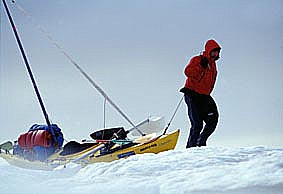 |
|||
| Stage
6 -
Mike Horn leaves Alaska - 19th of
August 2003 Mike arrived at Point Hope on the morning of the 13th of August. He greeted his 24ft Corsair Marine trimaran at Point Lay, only 130 miles of Point Hope and from there, sailed 16hrs south to the western most point of the American continent. On arriving at Point Hope, Mike was met by his wife, Cathy, and two daughters, Annika and Jessica. Point Hope is the oldest existing whaling village on the American continent where the local people have charmed Mike and his visitors with their kindness. This village is the last village that Mike will set foot in before his crossing of the Bering Strait and his arrival on Siberian territory. At Point Hope he will sail over the Bering Strait into Siberia continuing his 20'000kms tour around the Arctic Circle. |
||||
|
Stage
7 - Mike Horn starts his
trek over Russia - 17th of December 2003 Today, I start my trek. My equipment is packed and I'm ready. I will then head up north overland and then try and cross the mountains in Chukotka before getting back on the Arctic ocean. It is a detour of 600 km, but it is nothing in comparison with the remaining 10'000km I have to do, until I can to get back home." Stage
8 - Mike Horn enters the region of Yakutia - 7th
of March 2004 I'm hauling 160kgs of equipment and sledge behind me and averaging around 20-25kms a day. It's once again the season when the polar bears come out with their newly born cubs so it's at this time of year I must be very careful about the company I keep. In Chokurdakh I hope to meet up again with my logistics crew. I desperately need new supplies of food and equipment." |
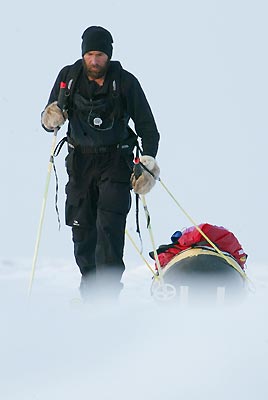 |
|||
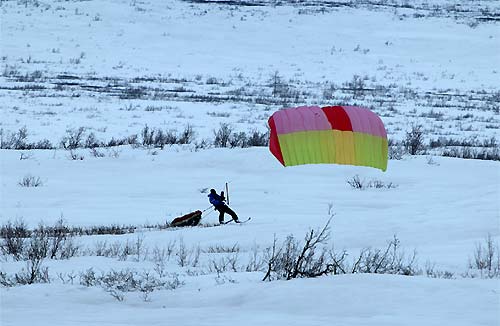 |
Stage
9 - Mike Horn leaves Noril'sk for Murmansk -
16th of June 2004 Mike has decided not to stop. For the time being he will continue on skis, pulling his sledge behind him until he can go no further. "My predicted arrival date at the North Cape is mid September 2004 - two years and one month after the starting date!! It's been a long haul but what an amazing adventure! I'm looking forward to coming home!" |
|||
| 21st
of September - Mike Horn will not finish his tour of the Arctic Circle
at the end of September!! Mike Horn is blocked in Tobseda, Russia, due to damage on the boat. He is unable to start 'stage 10' of the expedition, the last step in which he will complete his two year tour of the Arctic Circle. Mike reports, " I fought for 4 days non-stop to try and save my boat. It was moored in the bay but the winds were so strong that the boat was being pushed in all directions. The three anchors were not holding the boat in place. The winds were just too strong - I would say up to 80 kms an hour!!! Me, by myself, I fought all I could to control the boat but it was impossible. I haven't slept for 4 days!" After the repair of the first fissure, Mike unfortunately noticed other damage to the boat, and it now became impossible for him to put the boat back into the water. |
||||
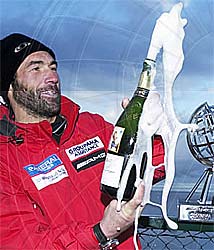 |
Stage
10 - |
|||